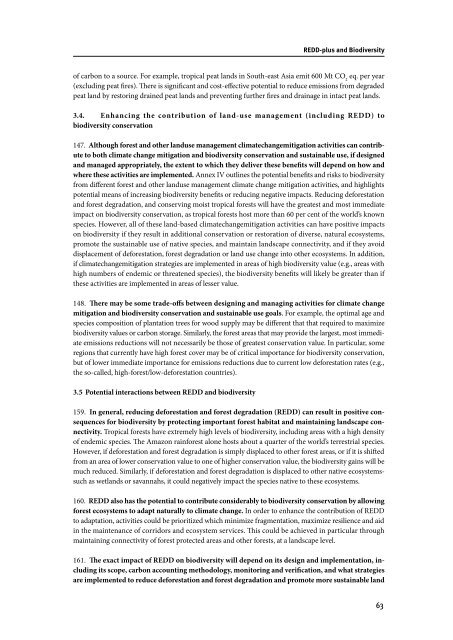REDD-plus and Biodiversity - Convention on Biological Diversity
REDD-plus and Biodiversity - Convention on Biological Diversity
REDD-plus and Biodiversity - Convention on Biological Diversity
Create successful ePaper yourself
Turn your PDF publications into a flip-book with our unique Google optimized e-Paper software.
<str<strong>on</strong>g>REDD</str<strong>on</strong>g>-<str<strong>on</strong>g>plus</str<strong>on</strong>g> <str<strong>on</strong>g>and</str<strong>on</strong>g> <str<strong>on</strong>g>Biodiversity</str<strong>on</strong>g><br />
of carb<strong>on</strong> to a source. For example, tropical peat l<str<strong>on</strong>g>and</str<strong>on</strong>g>s in South-east Asia emit 600 Mt CO 2<br />
eq. per year<br />
(excluding peat fires). There is significant <str<strong>on</strong>g>and</str<strong>on</strong>g> cost-effective potential to reduce emissi<strong>on</strong>s from degraded<br />
peat l<str<strong>on</strong>g>and</str<strong>on</strong>g> by restoring drained peat l<str<strong>on</strong>g>and</str<strong>on</strong>g>s <str<strong>on</strong>g>and</str<strong>on</strong>g> preventing further fires <str<strong>on</strong>g>and</str<strong>on</strong>g> drainage in intact peat l<str<strong>on</strong>g>and</str<strong>on</strong>g>s.<br />
3.4. Enhancing the c<strong>on</strong>tributi<strong>on</strong> of l<str<strong>on</strong>g>and</str<strong>on</strong>g>-use management (including <str<strong>on</strong>g>REDD</str<strong>on</strong>g>) to<br />
biodiversity c<strong>on</strong>servati<strong>on</strong><br />
147. Although forest <str<strong>on</strong>g>and</str<strong>on</strong>g> other l<str<strong>on</strong>g>and</str<strong>on</strong>g>use management climatechangemitigati<strong>on</strong> activities can c<strong>on</strong>tribute<br />
to both climate change mitigati<strong>on</strong> <str<strong>on</strong>g>and</str<strong>on</strong>g> biodiversity c<strong>on</strong>servati<strong>on</strong> <str<strong>on</strong>g>and</str<strong>on</strong>g> sustainable use, if designed<br />
<str<strong>on</strong>g>and</str<strong>on</strong>g> managed appropriately, the extent to which they deliver these benefits will depend <strong>on</strong> how <str<strong>on</strong>g>and</str<strong>on</strong>g><br />
where these activities are implemented. Annex IV outlines the potential benefits <str<strong>on</strong>g>and</str<strong>on</strong>g> risks to biodiversity<br />
from different forest <str<strong>on</strong>g>and</str<strong>on</strong>g> other l<str<strong>on</strong>g>and</str<strong>on</strong>g>use management climate change mitigati<strong>on</strong> activities, <str<strong>on</strong>g>and</str<strong>on</strong>g> highlights<br />
potential means of increasing biodiversity benefits or reducing negative impacts. Reducing deforestati<strong>on</strong><br />
<str<strong>on</strong>g>and</str<strong>on</strong>g> forest degradati<strong>on</strong>, <str<strong>on</strong>g>and</str<strong>on</strong>g> c<strong>on</strong>serving moist tropical forests will have the greatest <str<strong>on</strong>g>and</str<strong>on</strong>g> most immediate<br />
impact <strong>on</strong> biodiversity c<strong>on</strong>servati<strong>on</strong>, as tropical forests host more than 60 per cent of the world’s known<br />
species. However, all of these l<str<strong>on</strong>g>and</str<strong>on</strong>g>-based climatechangemitigati<strong>on</strong> activities can have positive impacts<br />
<strong>on</strong> biodiversity if they result in additi<strong>on</strong>al c<strong>on</strong>servati<strong>on</strong> or restorati<strong>on</strong> of diverse, natural ecosystems,<br />
promote the sustainable use of native species, <str<strong>on</strong>g>and</str<strong>on</strong>g> maintain l<str<strong>on</strong>g>and</str<strong>on</strong>g>scape c<strong>on</strong>nectivity, <str<strong>on</strong>g>and</str<strong>on</strong>g> if they avoid<br />
displacement of deforestati<strong>on</strong>, forest degradati<strong>on</strong> or l<str<strong>on</strong>g>and</str<strong>on</strong>g> use change into other ecosystems. In additi<strong>on</strong>,<br />
if climatechangemitigati<strong>on</strong> strategies are implemented in areas of high biodiversity value (e.g., areas with<br />
high numbers of endemic or threatened species), the biodiversity benefits will likely be greater than if<br />
these activities are implemented in areas of lesser value.<br />
148. There may be some trade-offs between designing <str<strong>on</strong>g>and</str<strong>on</strong>g> managing activities for climate change<br />
mitigati<strong>on</strong> <str<strong>on</strong>g>and</str<strong>on</strong>g> biodiversity c<strong>on</strong>servati<strong>on</strong> <str<strong>on</strong>g>and</str<strong>on</strong>g> sustainable use goals. For example, the optimal age <str<strong>on</strong>g>and</str<strong>on</strong>g><br />
species compositi<strong>on</strong> of plantati<strong>on</strong> trees for wood supply may be different that that required to maximize<br />
biodiversity values or carb<strong>on</strong> storage. Similarly, the forest areas that may provide the largest, most immediate<br />
emissi<strong>on</strong>s reducti<strong>on</strong>s will not necessarily be those of greatest c<strong>on</strong>servati<strong>on</strong> value. In particular, some<br />
regi<strong>on</strong>s that currently have high forest cover may be of critical importance for biodiversity c<strong>on</strong>servati<strong>on</strong>,<br />
but of lower immediate importance for emissi<strong>on</strong>s reducti<strong>on</strong>s due to current low deforestati<strong>on</strong> rates (e.g.,<br />
the so-called, high-forest/low-deforestati<strong>on</strong> countries).<br />
3.5 Potential interacti<strong>on</strong>s between <str<strong>on</strong>g>REDD</str<strong>on</strong>g> <str<strong>on</strong>g>and</str<strong>on</strong>g> biodiversity<br />
159. In general, reducing deforestati<strong>on</strong> <str<strong>on</strong>g>and</str<strong>on</strong>g> forest degradati<strong>on</strong> (<str<strong>on</strong>g>REDD</str<strong>on</strong>g>) can result in positive c<strong>on</strong>sequences<br />
for biodiversity by protecting important forest habitat <str<strong>on</strong>g>and</str<strong>on</strong>g> maintaining l<str<strong>on</strong>g>and</str<strong>on</strong>g>scape c<strong>on</strong>nectivity.<br />
Tropical forests have extremely high levels of biodiversity, including areas with a high density<br />
of endemic species. The Amaz<strong>on</strong> rainforest al<strong>on</strong>e hosts about a quarter of the world’s terrestrial species.<br />
However, if deforestati<strong>on</strong> <str<strong>on</strong>g>and</str<strong>on</strong>g> forest degradati<strong>on</strong> is simply displaced to other forest areas, or if it is shifted<br />
from an area of lower c<strong>on</strong>servati<strong>on</strong> value to <strong>on</strong>e of higher c<strong>on</strong>servati<strong>on</strong> value, the biodiversity gains will be<br />
much reduced. Similarly, if deforestati<strong>on</strong> <str<strong>on</strong>g>and</str<strong>on</strong>g> forest degradati<strong>on</strong> is displaced to other native ecosystemssuch<br />
as wetl<str<strong>on</strong>g>and</str<strong>on</strong>g>s or savannahs, it could negatively impact the species native to these ecosystems.<br />
160. <str<strong>on</strong>g>REDD</str<strong>on</strong>g> also has the potential to c<strong>on</strong>tribute c<strong>on</strong>siderably to biodiversity c<strong>on</strong>servati<strong>on</strong> by allowing<br />
forest ecosystems to adapt naturally to climate change. In order to enhance the c<strong>on</strong>tributi<strong>on</strong> of <str<strong>on</strong>g>REDD</str<strong>on</strong>g><br />
to adaptati<strong>on</strong>, activities could be prioritized which minimize fragmentati<strong>on</strong>, maximize resilience <str<strong>on</strong>g>and</str<strong>on</strong>g> aid<br />
in the maintenance of corridors <str<strong>on</strong>g>and</str<strong>on</strong>g> ecosystem services. This could be achieved in particular through<br />
maintaining c<strong>on</strong>nectivity of forest protected areas <str<strong>on</strong>g>and</str<strong>on</strong>g> other forests, at a l<str<strong>on</strong>g>and</str<strong>on</strong>g>scape level.<br />
161. The exact impact of <str<strong>on</strong>g>REDD</str<strong>on</strong>g> <strong>on</strong> biodiversity will depend <strong>on</strong> its design <str<strong>on</strong>g>and</str<strong>on</strong>g> implementati<strong>on</strong>, including<br />
its scope, carb<strong>on</strong> accounting methodology, m<strong>on</strong>itoring <str<strong>on</strong>g>and</str<strong>on</strong>g> verificati<strong>on</strong>, <str<strong>on</strong>g>and</str<strong>on</strong>g> what strategies<br />
are implemented to reduce deforestati<strong>on</strong> <str<strong>on</strong>g>and</str<strong>on</strong>g> forest degradati<strong>on</strong> <str<strong>on</strong>g>and</str<strong>on</strong>g> promote more sustainable l<str<strong>on</strong>g>and</str<strong>on</strong>g><br />
63

















